Predicting SDSU Men’s Basketball’s starters and rotation
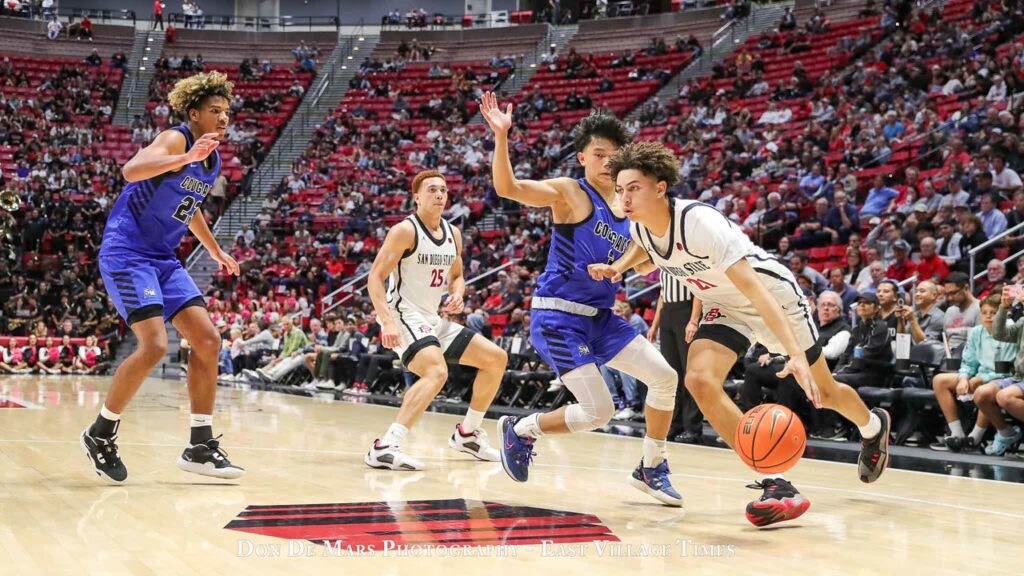
Miles Byrd drives to basket as Elijah Saunders watches from the perimeter. (Don De Mars/EVT)
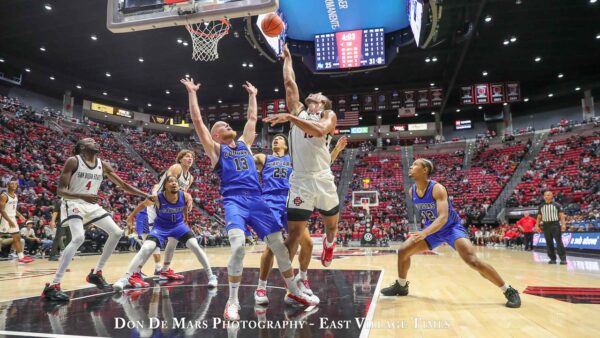
Part three of the East Village Times preview of SDSU Men’s Basketball season, in many ways, dictates much of what was discussed in parts one and two. The Aztecs’ offensive and defensive game plans will take shape according to the strengths of the athletes on the court.
Last season, head coach Brian Dutcher threw wave after wave of talented players at the opposition. The tactic allowed SDSU to wear down its opponents and play 40 minutes of suffocating defense without respite. While pundits made much of SDSU’s depth, it was not the quantity of Aztecs in the rotation but the quality of time each received that separated it from most teams.
Darrion Trammell’s 27.2 minutes per game paced the Aztecs a year ago. 1,074 players in the NCAA, including 35 from the Mountain West, averaged more minutes than Trammell. His total was the fewest average minutes to lead an SDSU team since at least the 1991-1992 season.
With fewer minutes given to the players at the top of the rotation, those at the bottom saw more time. Aguek Arop was one of nine players to play in 37 out of the Aztecs’ 39 contests. He played 16 minutes per game. Since Dutcher took over as head coach, it was the highest total any athlete at the end of the rotation has earned.
In the two exhibition games, Dutcher played nine and ten players who are competing for time this year. BJ Davis did not play against Arizona State but saw action against Cal State San Marcos. Add Trammell and Cade Alger, who watched Monday’s exhibition in street clothes, and the staff has 12 scholarship athletes to set their rotation.
Predicting SDSU’s Starters and Rotation
In the third of the East Village Times’ preview of the 2023-2024 season, EVT contributors Chris Spiering, Tron Johnson, Andre Haghverdian, and Paul Garrison take aim at answering some of the key questions facing the Aztecs this upcoming season.
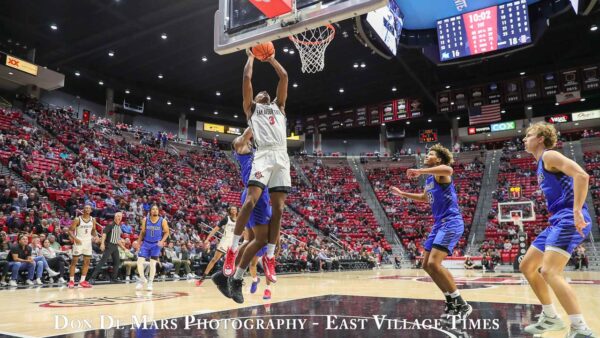
Did the coaching staff learn how to play more players last season, or did the players necessitate a deeper rotation?
Andre Haghverdian
It was definitely more the case that the roster from last season required a deeper rotation. The level of experience and talent made a nine-man rotation paramount to the success of the team. All four reserves could easily have been starters. The gap between the nine was too narrow to favor longer minutes for the starters over the reserves. But, the success of a deeper rotation could give coach Dutcher more confidence in playing nine or ten players deep this season, depending on how the season plays out.
Tron Johnson
The players necessitated it. The team was deep last season, but the coaches played a 10-man rotation in 2020-21, which was deeper than last season’s 9-man rotation. So it’s nothing new for them. If the players earn minutes, they will get minutes.
Paul Garrison
The staff learned how to play more athletes last season. Whatever the theoretical exercise of setting a rotation, it would be impossible for a coach as good as Dutcher not to learn from the experience. Specifically, the staff kept its rotation the same even in big games. In years past, they changed their style of play and gave extra minutes to their stars.
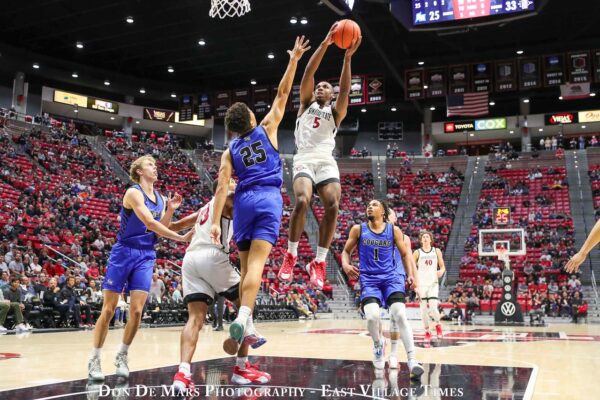
By the conference tournament, how many players will SDSU use in its rotation?
Chris Spiering
Last season, SDSU had nine players appear in at least 37 games. I expect by the time the conference tournament begins, nine will be in the rotation once again.
Andre Haghverdian
Nine feels like the right number again this season, with the backup center position vying for the ninth spot between Demarshay Johnson and Miles Heide. Barring injury or extreme foul trouble, there isn’t room for both big men in the rotation this season, so that competition will be a critical one in the first month of the year. The main difference will likely be the disbursement of the minutes. Last year, the nine players averaged between 16 and 27 minutes per game. This season, the top two or three players will likely play closer to 30 minutes per night, while the eighth and ninth players will get closer to 10.
Tron Johnson
It should be nine players again. Most teams shorten their rotation for the tournament, but when there isn’t much of a drop-off in the depth, then it’s actually beneficial to play more guys as their legs stay fresher. Coach Dutcher has won three tournament titles in six years. Coach Fisher won four titles in eighteen years. Dutcher took over a better situation, but even with that, he’s been way more successful in the tournament. He’s doing something right, and depth is a big part of it.
Paul Garrison
This year’s rotation will resemble prior seasons more than last year’s. Health permitting, Jaedon LeDee will average more than 30 minutes a game. Darrion Trammell and Lamont Butler might as well. Those extra minutes for SDSU’s best players will mean fewer minutes for those down in the rotation. In-game dynamics might dictate nine players compete regularly, but only seven or eight will be in the planned rotation.
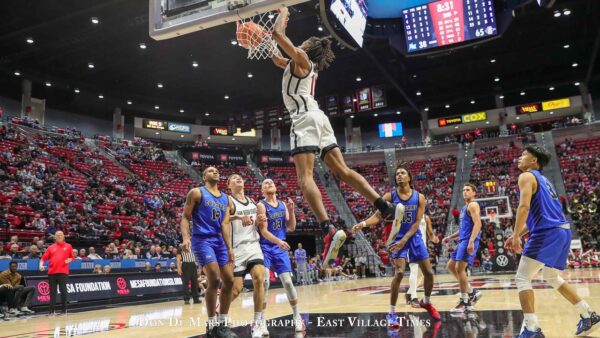
Who will start for the Aztecs?
Chris Spiering
Darrion Trammell, Lamont Butler, Reese Waters, Micah Parrish, and Jaedon LeDee.
Andre Haghverdian
Darrion Trammell, Lamont Butler, Reese Waters, Micah Parrish, and Jadeon LeDee. Although the staff may prefer to have LeDee at the four spot more prominently, the lack of an established starting center requires him to start at the five. The only unknown then lies at the four spot, with Parrish, Jay Pal, and Elijah Saunders vying for that role. Dutcher is not a coach that likes to change starting lineups based on opponent matchups, so I expect him to pick one of those three and stick with him throughout the season, barring injury.
Tron Johnson
Darrion Trammell, Lamont Butler, Reese Waters, Micah Parrish, Jaedon LeDee. It won’t surprise if Pal earns a starting spot at some point in the year, but Parrish starting at the 4 in the secret scrimmage indicates that the coaches are leaning in that direction.
Paul Garrison
The difference between the first exhibition and the second was switching Heide for Saunders. The look Saunders gave provided a glimpse at the four-wing, one-post look that appears to be how SDSU will start the season once Trammell is healthy. Waters, Parrish, Butler, LeDee, and Trammell will be given every opportunity to start, but Monday’s exhibition also showed the group is not set in stone. Waters allowed multiple layups and did not display the defensive intensity needed to compete in a leading role. Last year, LeDee was clearly among the Aztecs’ best offensive players. He averaged 18.1 minutes. Without improving on defense, Waters could be headed to the same role.
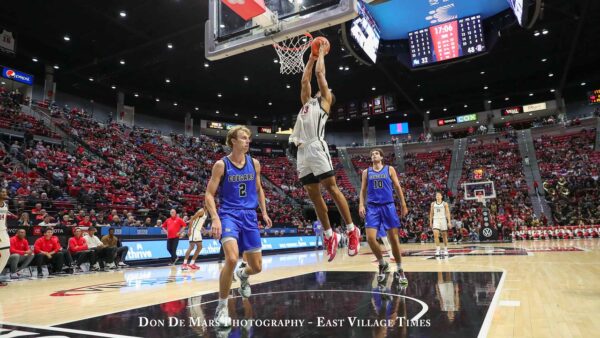
What do the coaches look for when selecting how the rotation works?
Chris Spiering
We all know the Aztecs mantra, “if you don’t play defense, you won’t play.” That is a given with this San Diego State Men’s basketball team. Defense plays a major role when the SDSU coaching staff decide their rotations. However, much like any coach would, size and a rim protector is needed on the floor at all times.
The Aztecs lost Nathen Mensah but have a core of talent ready to replace his presence at the rim. This coaching staff looks for guards who can run in transition as well as being able to play the pick-and-roll to be in tune with the big men. The Aztecs have some dynamic scorers who should play well with each other, and that starts in transition when the defense forces a stop.
Andre Haghverdian
Unlike other coaching staffs who are prone to tinkering with starting lineups throughout a season and for specific matchups, the SDSU staff likes to pick one lineup and stick with it throughout the season. The importance of the starting lineup is balancing the strengths and weaknesses of the five players into one cohesive offensive and defensive unit.
Certainly, having multiple ball handlers who can initiate the offense is paramount to the positionless style the team employs, but outside shooting is necessary to space the floor. Finally, the mantra of “if you don’t play defense, you won’t play” factors into rounding out the remaining rotation and typically plays itself out as the season progresses.
Tron Johnson
They tend to try and start the five players that work best together and then fit everyone else around that. It’s not always the five best players that start, but the guys that complement each other’s respective talents the best. One thing the coaches do a good job with is giving minutes to the players who are playing well that day. So the rotation isn’t set in stone. If the individual is showing well in practice and playing well on game day, they will get more minutes.
Paul Garrison
This season, the staff will be looking for players who bring out the best in their best players. Whether that’s allowing LeDee to play on the perimeter to showcase his entire game or providing a unique look when the starters are not in the game. Opportunities will be given to everyone early. Those who capitalize on them will earn more.
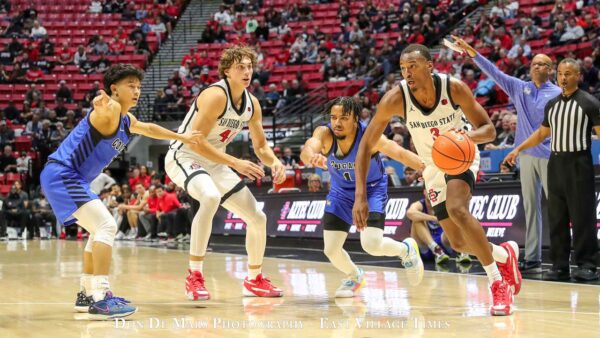
Which player will start lower in the rotation but work his way into a more prominent role?
Chris Spiering
Demarshay Johnson Jr. The former 3-star recruit from Richmond, California, was the No. 27 center in the nation his senior year of high school. As a redshirt freshman last season, Johnson appeared in nine games. The 6-foot-10 center has a chance to step up as the backup center. Johnson will compete with Miles Heide for minutes, but I expect Johnson’s role to increase with each appearance.
Andre Haghverdian
Pal is the likely answer here. After battling a minor injury throughout fall practice and in is first year in the program, he is essentially starting out as the eighth player in the rotation behind Miles Byrd and Saunders, who have one year in the program already. Pal possesses qualities that the coaching staff loved abouthim are still there, but just need time to be fully shown. His versatility on both ends of the floor should shine as he gets minutes early in non-conference play to the point where coach Dutcher will want him on the floor more, especially in crunch-time situations.
Tron Johnson
Jay Pal. He has all the tools to fit in the starting lineup. He has length, defensive versatility, he’s an excellent rebounder, and is great at playing off the ball offensively. He’s a guy coaches don’t need to draw plays for, and he’ll still impact the game. He’s similar to Jalen McDaniels as a freshman in that regard. He’s been limited by injuries so far, and that has slowed down the process of getting used to the new system. By the time the season is winding down, his minutes should increase a lot.
Paul Garrison
Saunders is the answer to this question. He might not start, but as time goes on, his size, athleticism, and knowledge of the defense at SDSU will allow him to finish games. Last year, he practiced all of the defensive techniques the Aztecs used, and that will pay off with more time this year.
My earliest sport’s memory involve tailgating at the Murph, running down the circular exit ramps, and seeing the Padres, Chargers and Aztecs play. As a second generation Aztec, I am passionate about all things SDSU. Other interests include raising my four children, being a great husband and teaching high school.